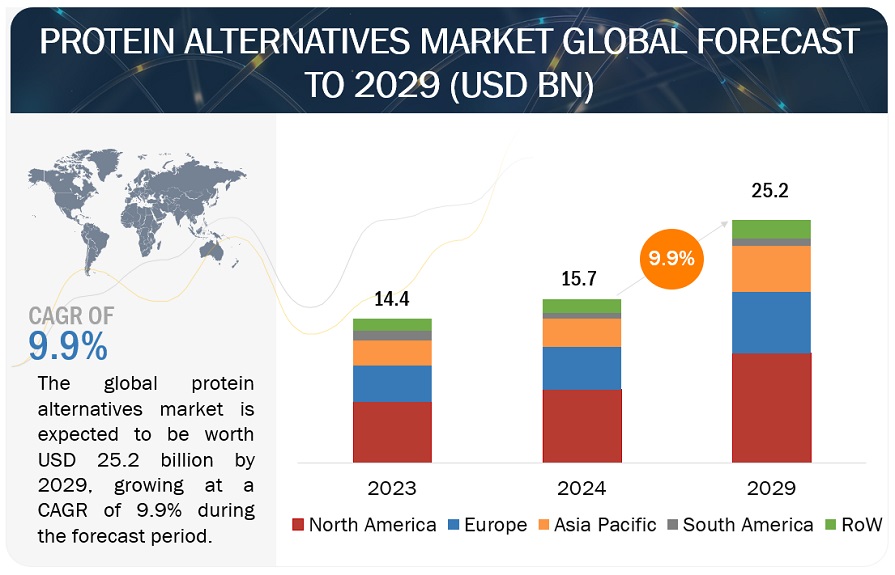The global protein alternatives market is estimated at USD 15.7 billion in 2024; it is projected to grow at a CAGR of 9.9% to reach USD 25.2 billion by 2029. The protein alternatives market has experienced rapid growth and diversification in recent years, driven by increasing consumer demand for sustainable, health-conscious, and ethically produced food options. Key drivers of this market include rising concerns over the environmental impact of traditional animal agriculture, the health benefits associated with plant-based diets, and ethical considerations regarding animal welfare. Major segments within the protein alternatives market include plant-based proteins, insect-based proteins, and microbial proteins. Companies like Beyond Meat, Impossible Foods, and Oatly have become household names, reflecting the mainstream acceptance and expanding consumer base for these products. Technological advancements and significant investments from both food industry giants and venture capitalists have further accelerated the development and accessibility of innovative protein alternatives.

Download PDF Brochure: https://www.marketsandmarkets.com/pdfdownloadNew.asp?id=233726079
Driver: Increasing Demand for Alternate Protein
The increasing global population underscores the necessity for alternative protein sources. Over the past decade, significant efforts have focused on developing proteins from non-traditional crops and livestock. This trend is particularly noticeable in Europe and North America, where consumer interest and investment in alternative proteins have surged. The conventional sources of animal protein like pork, beef, and chicken are projected to be insufficient to meet future demands, creating opportunities for the expansion of the insect protein market. In addition to proteins and fats, insects are valued for their rich mineral and vitamin content. Among younger demographics, particularly in sports nutrition, insect proteins, such as cricket flour, are gaining popularity and are being incorporated into various nutritious food products. For instance, startups like Next Step Foods in the UK produce cricket protein bars like “Yuana” available in multiple flavors.
The shift to alternative proteins also promises environmental benefits, notably in reducing greenhouse gas emissions compared to traditional meat production, as highlighted by the World Economic Forum in 2019. Moreover, adopting alternative proteins addresses diet-related health concerns in developing countries and promotes healthier lifestyles in developed regions such as North America and Europe. These areas have already embraced alternative protein sources such as edible insects, plant-based meat, plant protein ingredients, and cultured meat. Industry experts predict significant market growth potential for these products, with cultured and plant-based meat alone expected to see over 40% growth in the coming years.
In 2022, a study funded by the European Regional Development Fund revealed that 22% of UK consumers preferred alternative protein sources over meat, with the younger demographic showing an even higher preference exceeding 25%. These trends underscore the growing market opportunities in the insect protein sector.
Based on nature, the organic subsegment is estimated to grow at the fastest CAGR during the studied period.
Consumers are increasingly turning towards plant-based and organic protein sources as they become more health-conscious and environmentally aware. This shift is driven by concerns over animal welfare, sustainability, and the desire for cleaner, healthier eating options. Organic protein alternatives, such as plant-based meats, dairy substitutes, and protein-rich grains like quinoa and lentils, are gaining popularity due to their perceived health benefits and minimal environmental impact. Companies in this sector are innovating rapidly to meet rising demand, offering a diverse range of products that cater to various dietary preferences and nutritional needs. As a result, the protein alternatives market is not only expanding in size but also evolving in terms of product offerings and market reach.
Moreover, the growth in the protein alternatives market is bolstered by changing consumer behaviors and preferences towards more sustainable lifestyles. As awareness of climate change and resource depletion increases, consumers are seeking out products that align with their values of sustainability and ethical sourcing. Protein alternatives not only offer a viable substitute to traditional animal-based proteins but also often boast certifications that ensure they are produced using environmentally friendly practices. This growing market trend is attracting investment from both established food companies and startups alike, driving further innovation and market expansion. Overall, the organic nature of the protein alternatives market reflects a broader societal shift towards healthier, more sustainable food choices, shaping the future landscape of the food industry.
Make an Inquiry: https://www.marketsandmarkets.com/Enquiry_Before_BuyingNew.asp?id=233726079
The Asia Pacific region is anticipated to experience the most rapid growth between 2024 and 2029.
The protein alternatives market in the Asia Pacific region is witnessing rapid expansion, driven by heightened consumer awareness of health benefits, immunity enhancement, and environmental sustainability. This shift towards protein sources beyond traditional animal products underscores a growing recognition of the health advantages associated with plant-centric diets, including lower risks of chronic illnesses and bolstered immune systems. Concurrently, rising concerns over environmental sustainability, such as the impact of animal agriculture on carbon emissions and land use, are prompting consumers to adopt plant-based alternatives. This evolving trend is bolstered by advanced food technologies that offer a diverse array of plant-based protein products tailored to meet the region’s diverse culinary preferences. Consequently, the Asia Pacific region is emerging as a significant force in shaping the global protein alternatives market, poised for sustained growth and continuous innovation in the foreseeable future.
Key Market Players in this include Tate & Lyle PLC (London), Kerry Group PLC (Ireland), DSM Firmenich (Switzerland, ADM (US), Cargill Incorporated (US), International Flavors & Fragrances Inc. (US), Ingredion (US), Roquette Frères (France), Wilmar International Ltd. (Singapore), Glanbia plc (Ireland), Kerry Group PLC (Ireland), DSM-Firmenich (Switzerland), AGT Food and Ingredients (Canada), Burcon (Canada), Ynsect (France), Global bugs (Thailand), and Innovafeed (France).
Other players include BENEO GmbH (Germany), SOTEXPRO (France), Shandong Jianyuan Group (China), AMCO Proteins (US), Australian Plant Proteins Pty Ltd (Australia), nextProtein (France), Mycorena (Sweden), Burcon NutraScience Corporation (Canada), Emsland Group (Germany), COSUCRA (Belgium) and Hexafly (Ireland).
